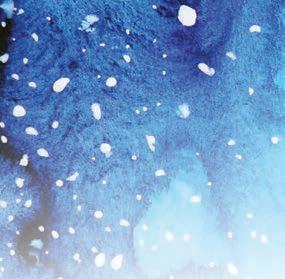
4 minute read
Restoring a Sense of Wonder and





Restoring a Sense of Wonder and Mystery BY PHILIP CHARD






I’m mourning the loss of wonder, of mystery,” Peter told me, hands folded, eyes down. A vacancy tinged with sadness inhabited his gaze. With almost 70 years on the planet, this man had lived a full life, one populated with purpose and goodness. But as he made his way through his 60s, his outlook soured. Not because some awful event or condition took him hostage, but due to his increasing sensitivity to what’s broken in our species and how we treat each other and the planet. Peter is a “highly sensitive person,” belonging to a subset of our population who feel more deeply than the norm, whatever that is. They are highly empathic and tuned in to emotions and states of mind in others; a capacity that proves both a blessing and a curse. It becomes a curse when they lock on to pain in others, as well as the collective emotional tone of their community, be that local, national, global or the entirety. Over time, this can create what psychologists call a “negative cognitive bias.” The brain becomes accustomed to scanning for what’s wrong, unfair, frightening and hurtful, while overlooking or discounting what’s right, just and good. Unless facile in self-care and emotional healing, these folks gradually but inexorably accumulate
“ the weight of the sorrow, angst and tragedy they absorb from the world. Peter was such a soul. “As a kid, I was full of wonder and curiosity,” he told me. “Especially anything to do with nature, like astronomy, biology, the microscopic world and the sciences in general. They connected me with the mystery of it all.”
SENSE OF AWE
Peter’s longing to explore what eludes our cognitive grasp was a powerful force shaping his personality. He described how his fascination with the physical world seemed to whisper to him through his

senses, beckoning him to look deeper. And the deeper he gazed, with reading, classes and experiences in the natural world, the more he sensed the presence of forces hiding within so-called physical reality. This created a sense of awe and wonder. It’s what we feel when gazing, awestruck, at a magnificent sunset, a dazzling rainbow, a whale breaching over open sea or the gaze of a newborn child. We sense the mystery but, in trying to describe it, mostly stumble. It is, as the philosophers remind us, ineffable (too profound for words).
“Besides my family and close friends, it was the most important thing in my life. I’m not sure how to live without it,” he explained.
To lose touch with something so precious and life-giving can be tragic. Einstein told us, “He who can no longer pause to wonder and stand rapt in awe, is as good as dead.” Unfortunately, my profession displays a predilection for labeling this spiritual malady as merely psychological. Peter endured this when the first two counselors he visited pronounced him “clinically depressed,” while a psychiatrist added the term “dysthymia.” It was during a conversation with his spouse that he discovered what truly ailed him. She shared how it seemed as if he had lost his sense of “wonder,” and, in its place, occupied a state of being bereft of mystery. Her pronouncement evoked an immediate “Aha!” in his brain.
“Is it even possible to bring this kind of consciousness back?” he wondered.
Well, one can’t summon what lyricists call “the eyes of a child” by brute force of will or sneaky sleight of mind. We can’t go find it. Rather, we need to create conditions that help it find us. But how? Mostly, it comes down to two key factors; setting and set. We need to inhabit physical settings that possess the sensory richness and beauty capable of eliciting awe and wonder. Often, these are in the natural world, but not always. Architectural spaces can cultivate an ambience of wonderment, as well. The other factor — set — refers to one’s mindset while in a beatific setting. Creating a conducive state of mind, or set, requires exercising intentional influence over one’s thoughts and actions. Peter didn’t require any suggestions on settings. An outdoor type, he quickly identified several locales he planned to inhabit. When it came to set, however, he needed some guidance. I encouraged him to restart his meditation practice, as well as begin yoga and gratitude journaling, all to promote positivity and mindfulness. What’s more, I suggested he develop an artistic pursuit that required collaborating with nature. He selected photography.
Sound like a lot of effort? Granted, but well worth it. One’s soul is at stake. As the Irish poet W.B. Yeats reminded us, “The world is full of magic things, patiently waiting for our senses to grow sharper.”
For more, visit philipchard.com.
Philip Chard is a psychotherapist and author with a focus on lasting behavior change, emotional healing and adaptation to health challenges. For more, visit philipchard.com.










